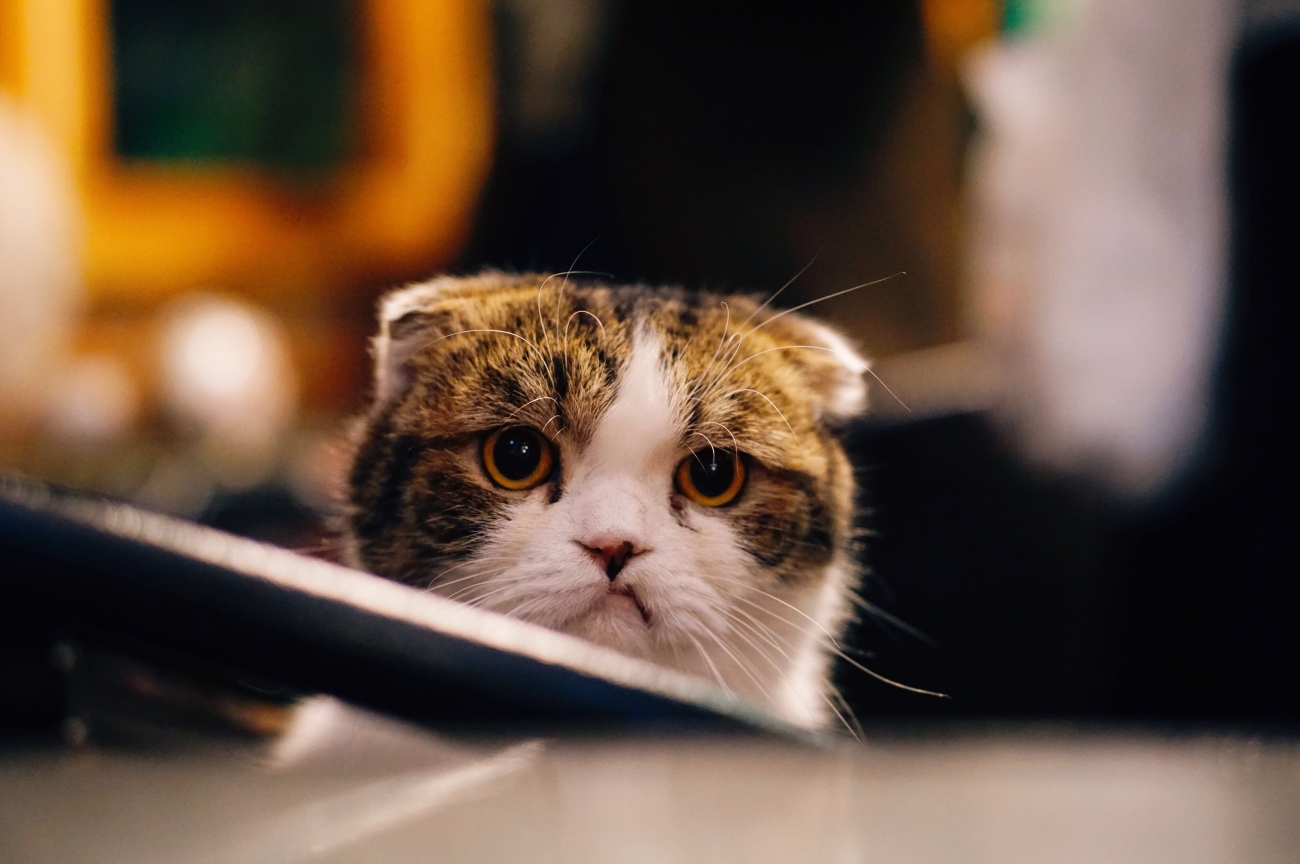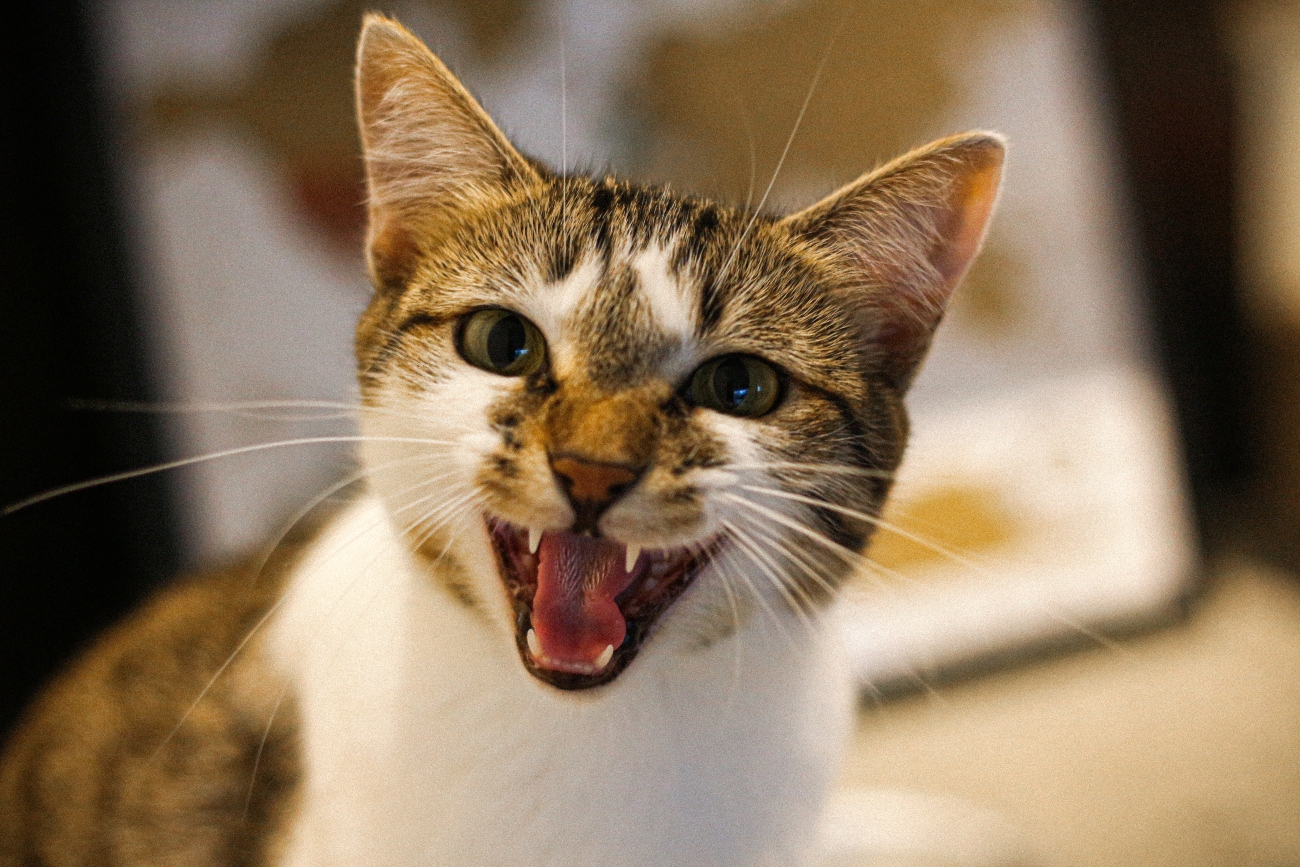
How to calm down an angry cat
4th November, 2021
Cats are well known for being temperamental. They can go from being friendly to fiery in a second – and it sometimes doesn’t take much at all for them to flip! It’s part of the reason we love them so much. But, faced with a furious feline, you’ve got to know what to do so that you and your beloved pet don’t get hurt.
An angry cat can do a lot of damage to someone if they are not managed properly. They might only have relatively small mouths, but those teeth can still pack a punch. Unlike a dog, they also have four paws which can act as a weapon, potentially inflicting severe lacerations that can be painful and become infected.
In a recent cat attack in Worthing, West Sussex, a woman described how she was left with 24 puncture wounds after a fiery feline took a dislike to her. The cat, owned by a local councillor, was said to be “wonderful” and "everyone likes him". But the victim described the cat very differently, calling it “deranged and vicious”.
It sums up just how unpredictable cats can be at times (which is why you need cat insurance to protect you from those unexpected events). But if you can understand cat cues, you can often avoid aggression turning into conflict.

Reading cat cues is easier said than done
You don’t have to be a cat whisperer to understand what a feline is feeling. But it’s not always easy to read what a cat is telling you with their body language and expressions alone.
In a major study of 6,329 people from 85 countries, participants were, on average, only around 50% successful when trying to read whether the cat in question was distressed or happy. They watched between two to 20 short videos of cat expressions, scoring an average of 11.85 out of 20 ratings correct.
Understanding a cat’s behaviour is good for more than spotting the signs of anger and aggression. It can help you spot ill health and depression in your feline friend, and respond accordingly.
Cat food specialists Purina has put together a handy guide to cat behaviour, which we have condensed below:
- Neutral (relaxed) – This is how you want to see your cat most of the time: chilled and happy in their surroundings. This is perhaps the easiest emotion to recognise in your cat, as they will usually just be half-asleep with not a care in the world.
- Focused – If you let your cat roam outside, you will know that they are excellent hunters, bringing all kinds of ‘presents’ back to the house. You’ve probably seen your cat in focused, hunt mode: their pupils will be narrowed, ears and whiskers pricked forward, with their body low to the ground ready to pounce.
- Happy – There is no better sight than a happy cat. Lying down, they have their paws tucked neatly underneath them, content in the knowledge they’re not under threat and can sit comfortably. If you stroke them, they might let out a gentle purr or meow, vocalising their happiness.
- Anxious – Cats can be anxious creatures, with just a slight change in circumstances or surroundings enough to send them off-kilter. Their tail is usually the tell-tale sign of anxiety – it might be still or moving slowly side to side at the tip. Their head might be lower, too, with their whiskers pulled back to the side, crouching so as to appear unthreatening.
- Fearful – Fear is more obvious to spot than anxiety – they will likely try and hide from the thing that they’re scared of by hiding or crouching very still. Their ears will be flat back against their head and eyes open wide – they may even hiss or spit if the threat is close.
- Frustrated – Frustration can be short term for a cat or longer term, built up over time due to a lack of stimulation like not being able to indulge their hunting instincts. If it’s the former, it will usually be easier to diagnose their source of frustration – they will be intently focusing on the toy or other object that is out of reach. Long-term frustration can manifest into lethargy and a general lack of lust for life – they might even go off their food.
What are the cues of an angry cat?
It makes sense to spend a little longer looking at some of the cues of an angry cat – although, it will often be quite obvious when you’ve got a feisty feline on your hands!
They will be rigid, with their tail either erect or curled around and under their body. It’s all part of their attempts to make themselves look threatening – their fur will raise too, with their eyes hard and focussed on everything they perceive to be a threat. If they start hissing or lurching towards you or somebody else, you know that you’ve got a real situation on your hands.
In order to defuse it, it can help to understand why the cat in question is acting the way it is. Here are four typical reasons why a cat might be showing a side you’ve never seen before:
- They’ve gone into self- protection mode. A cat’s first means of defence is to run, but sometimes it can’t see a way out, so it turns to attack as a way to protect itself. Of course, what your cat perceives as danger and what you do are two very different things. Cats are very emotionally tuned and can sense when things aren’t the norm. Perhaps there’s someone new in the house that they’re not comfortable around and believes them to be a threat. But it’s not always possible to work out why they are acting the way they are – it can sometimes stem back to an experience or lack of socialisation as a kitten, before they were in your possession. When they lash out, they can cause themselves an injury. Cat insurance can help with any emergency treatment they might need.
- They’re just trying to play. Watching two kittens play fight is really cute – they will scratch and bite each other, but stop short of doing any real damage. However, this play fighting becomes distinctly less cute if you’re on the other end of it as they get older and stronger. Cats can be quite aggressive in their play, and are left confused when we don’t respond in the same way as we did before, which can lead to frustration and anger.
- They’re frustrated at something. A cat can get frustrated at all manner of things – from not being stimulated through play to seeing a strange new feline through the window. Unfortunately, as their owner, we are often the ones on the end of this frustration. Often referred to as “redirected aggression”, it’s important to recognise that cats don’t always know how to exhibit their frustration without resorting to aggression – don’t punish them for it, but keep yourself safe.
- They’re feeling under the weather. When we’re not quite feeling 100%, it often makes us short tempered and aggravated. When a cat is unwell, they have similar feelings, with some anxiety chucked in for good measure as they can’t understand why they feel like they do. This mixture of emotions can add up to shows of aggression, especially if you’ve failed to recognise that they are not feeling well and adapt your behaviour accordingly. Often your cat will just want to be left alone – that’s fine, but you should also get them booked in to see the vet to get to the route of the problem which could be anything from hyperthyroidism to osteoarthritis.

How to act around an angry cat
If your cat is showing all the signs of being angry, you have a few options. A simple solution is always to open a door and let them run away, allowing themselves to calm down naturally.
If they have a favourite toy that they like to play with, grab it if it’s within reach and see if that helps to redirect their aggression. It might just be a case that they have some frustration they need to get out of their system.
If their favourite toy isn’t doing the trick, make sure it’s not you that they are perceiving to be a threat. Show them you’re friendly by lying on the floor or sitting on the sofa while remaining at a distance. If they approach you, keep nice and still and avoid any sudden movements.
However, if this doesn’t take the edge off their anger and the cat has no intention of taking themselves away from the situation, you might have to restrain them or you could be their prey! Rather than going with bare hands and arms, grab a pillowcase or a blanket which can be used to pick them up. Once they are restrained, a cat will usually start to calm down.
Sometimes a cat will show fear and aggression when they sense that they’re about to be transported, to the vet or elsewhere. Again, picking them up with a towel, pillow case or blanket, smother your cat’s legs and body – ensuring you keep their head free – and you should then be able to get them in their carrier.
If your cat is regularly showing aggression, it’s advisable to speak to your vet. You could try calling the 24-Hour Vet Helpline that comes as part of your Purely Pets cat insurance, too.
What if you get bitten or scratched?
It’s not easy to deal with an angry cat and get away without them leaving their mark on you! While we might be bigger and stronger than them, they have speed and agility on their side.
If you get bitten or scratched, you should wash any wounds with clean, warm water and keep an eye on them. The trouble with teeth wounds from a cat is that the puncture holes in your skin close over quickly and can potentially trap bacteria deep in the tissue under the skin.
Depending on the nature of the wound, the bacteria can spread to surrounding tissues causing a condition called cellulitis. Infected people may suffer from fever and flu-like symptoms and can be really quite poorly unless the infection is dealt with.

If the wound becomes red and hot, this can be the sign of an infection, and you should seek medical attention.
Most of the time, as long as the bite and scratch marks are washed thoroughly, you will be OK. But it’s always wise to be cautious and speak to your GP if you are concerned.
For more on what diseases you can catch from your cat, check out our guide on exactly that. You might want to focus on the section on cat scratch disease (CSD). Caused by the Bartonella henselae bacteria, CSD, as you might’ve guessed, is caught from cats (often kittens) when they bite or scratch.
The symptoms of CSD include bumps or blisters where the bite happened, swollen lymph nodes, tiredness, fever and headaches. Even though this is a relatively harmless condition, it could affect children or those people with a weak immune system more severely. In the case that your cat is the one that is experiencing the fever, read our recent guide on caring for them.
Cat insurance from Purely Pets
As we know, cats are curious, feisty and adventurous creatures. These characteristics can see them getting into all kinds of scrapes. Cat insurance is a life-saver (nine times over, if necessary) for owners when your cat overestimates their abilities!
Here at Purely Pets, our cat insurance provides your cat with the care they need to make a swift recovery, so that they can get back to prowling round the garden, tucking into their favourite treats or lying in that special sunny spot in the living room.
Remember that policyholders can also call our 24-Hour Vet Helpline if they need advice about their poorly pet.